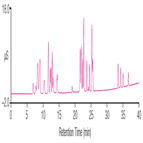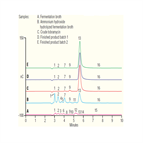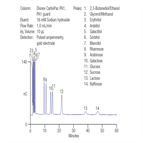Find methods for your needs
Refine by Feature
Displaying 1-5 of 9 results for Tag: fermentation broth
Concentration determination of a Bevacizumab harvest sample by using an Affinity capture Protein-A column
Instrument Type: HPLC (Biocompatible)The Thermo Scientific Dionex UltiMate 3000 LC Bio-LC system is applied for the affinity analysis for concentration determination of Bevacizumab Harvest Sample. The analysis was performed on a Thermo Scientific MabPac Protein A column with a UV detection at 280 nm. With a run time of 3.0 minutes, the method allows easy and fast estimation of Protein content in harvest sample of Bevacizumab. Linearity from 0.05-2.0 mg/mL with RSD of 0.5% (n=3)
AB104: Determination of 32 Low Molecular Mass Organic Acids in Biomass by Ion Chromatography Mass Spectrometry
Instrument Type: ICMSLow Molecular Mass Organic Acids (LMMOAs) are degradation products during pretreatment processes for biofuel production that are known to inhibit microbial fermentation processes, thus reduce the conversion efficiency of biomass to biofuels. To understand and optimize the conversion process, an IC/MS method to quantitate LMMOA profiles during biofuel production was developed. The IC/MS method is useful in separating and profiling close eluters using the power of high performance anion exchange chromatography coupled with multiple SIM scans to identify over 30 compounds in a single run.
AU167: Determination of Tobramycin in Crude and In-Process Production Samples During Manufacturing Using HPAE-IPAD
Instrument Type: ICThis update describes how tobramycin and its typical impurities can be determined in manufacturing process matrices using the same HPAE-IPAD method described in AN 61. The same method is used to assay tobramycin that is intentionally degraded, demonstrating its suitability as a stability indicating method. An ICS-6000 can be used for this application.
AN123: Determination of Inorganic Anions and Organic Acids in Fermentation Broths
Instrument Type: ICFermentation broths are complex mixtures of nutrients, waste products, cells and cell debris, and desired products. Fermentation monitoring is important for many industries because carbon sources and metabolic by-products can impact the yield of the desired products. This application note describes the use of two different anion-exchange columns, IonPac AS11 and IonPac AS11-HC, with suppressed conductivity detection, to analyze common organic and inorganic anions in yeast and bacterial fermentation broths.
AN122: The Determination of Carbohydrates, Alcohols, and Glycols in Fermentation Broths - Mono- and Disaccharides Method
Instrument Type: ICThis Application Note describes the use of two different anion-exchange columns with amperometric detection to analyze simple sugars, sugar alcohols, alcohols, and glycols in yeast and bacterial fermentation broths. The yeast Saccharomyces cerevisiae in Yeast Extract-Peptone-Dextrose (YPD) broth and the bacteria Escherichia coli (E. coli) in Luria-Bertani (LB) broth are common eukaryotic and prokaryotic fermentation systems, respectively. This record shows a method that is best for mono- and disaccharides.





